Temporal and Spatial Analysis of the Impact of the 2015 St. Patrick’s Day Geomagnetic Storm on Ionospheric TEC Gradients and GNSS Positioning in China Using GIX and ROTI Indices
Abstract
1. Introduction
2. Data and Methods
2.1. GNSS Data and Processing
2.2. Ionospheric Disturbance Indices GIX and ROTI
3. Results
3.1. Overview of Geomagnetic Storm Periods and Ionospheric TEC Gradients Between 1 January and 30 June 2015
3.2. TEC Spatial Gradient and GNSS Positioning During the March 2015 Storm
4. Discussion
5. Conclusions
Author Contributions
Funding
Data Availability Statement
Acknowledgments
Conflicts of Interest
References
- Kung Chie, Y.; Chao-Han, L. Radio wave scintillations in the ionosphere. Proc. IEEE 1982, 70, 324–360. [Google Scholar] [CrossRef]
- Kintner, P.M.; Ledvina, B.M.; De Paula, E.R. GPS and ionospheric scintillations. Space Weather 2007, 5, 2006SW000260. [Google Scholar] [CrossRef]
- DasGupta, A.; Ray, S.; Paul, A.; Banerjee, P.; Bose, A. Errors in position-fixing by GPS in an environment of strong equatorial scintillations in the Indian zone. Radio Sci. 2004, 39, 2002RS002822. [Google Scholar] [CrossRef]
- Jacobsen, K.S.; Dähnn, M. Statistics of ionospheric disturbances and their correlation with GNSS positioning errors at high latitudes. J. Space Weather Space Clim. 2014, 4, A27. [Google Scholar] [CrossRef]
- Dugassa, T.; Bosco Habarulema, J.; Nigussie, M. Investigation of the relationship between the spatial gradient of total electron content (TEC) between two nearby stations and the occurrence of ionospheric irregularities. Ann. Geophys. 2019, 37, 1161–1180. [Google Scholar] [CrossRef]
- Jakowski, N.; Stankov, S.M.; Klaehn, D. Operational space weather service for GNSS precise positioning. Ann. Geophys. 2005, 23, 3071–3079. [Google Scholar] [CrossRef]
- Nava, B.; Radicella, S.M.; Leitinger, R.; Coïsson, P. Use of total electron content data to analyze ionosphere electron density gradients. Adv. Space Res. 2007, 39, 1292–1297. [Google Scholar] [CrossRef]
- Lee, J.; Datta-Barua, S.; Zhang, G.; Pullen, S.; Enge, P. Observations of low-elevation ionospheric anomalies for ground-based augmentation of GNSS. Radio Sci. 2011, 46, RS6005. [Google Scholar] [CrossRef]
- Vukovic, J.; Kos, T. Ionospheric spatial and temporal gradients for disturbance characterization. In Proceedings of the 2016 European Navigation Conference (ENC), Helsinki, Finland, 30 May–2 June 2016; pp. 1–4. [Google Scholar] [CrossRef]
- Pi, X.; Mannucci, A.J.; Lindqwister, U.J.; Ho, C.M. Monitoring of global ionospheric irregularities using the Worldwide GPS Network. Geophys. Res. Lett. 1997, 24, 2283–2286. [Google Scholar] [CrossRef]
- Jakowski, N.; Hoque, M.M. Estimation of Spatial Gradients and Temporal Variations of the Total Electron Content Using Ground-Based GNSS Measurements. Space Weather 2019, 17, 339–356. [Google Scholar] [CrossRef]
- Cesaroni, C.; Spogli, L.; Alfonsi, L.; De Franceschi, G.; Ciraolo, L.; Galera Monico, J.F.; Scotto, C.; Romano, V.; Aquino, M.; Bougard, B. L-band scintillations and calibrated total electron content gradients over Brazil during the last solar maximum. J. Space Weather Space Clim. 2015, 5, A36. [Google Scholar] [CrossRef]
- Beach, T.L.; Kintner, P.M. Simultaneous Global Positioning System observations of equatorial scintillations and total electron content fluctuations. J. Geophys. Res. Space Phys. 1999, 104, 22553–22565. [Google Scholar] [CrossRef]
- Bhattacharyya, A.; Beach, T.L.; Basu, S.; Kintner, P.M. Nighttime equatorial ionosphere: GPS scintillations and differential carrier phase fluctuations. Radio Sci. 2000, 35, 209–224. [Google Scholar] [CrossRef]
- Sun, Y.Y.; Matsuo, T.; Araujo-Pradere, E.A.; Liu, J.Y. Ground-based GPS observation of SED-associated irregularities over CONUS. J. Geophys. Res. Space Phys. 2013, 118, 2478–2489. [Google Scholar] [CrossRef]
- Aa, E.; Zhang, S.R.; Erickson, P.J.; Wang, W.; Qian, L.; Cai, X.; Coster, A.J.; Goncharenko, L.P. Significant Mid- and Low-Latitude Ionospheric Disturbances Characterized by Dynamic EIA, EPBs, and SED Variations During the 13–14 March 2022 Geomagnetic Storm. J. Geophys. Res. Space Phys. 2023, 128, e2023JA031375. [Google Scholar] [CrossRef]
- Vo, H.B.; Foster, J.C. A quantitative study of ionospheric density gradients at midlatitudes. J. Geophys. Res. Space Phys. 2001, 106, 21555–21563. [Google Scholar] [CrossRef]
- Klimenko, M.V.; Zakharenkova, I.E.; Klimenko, V.V.; Lukianova, R.Y.; Cherniak, I.V. Simulation and Observations of the Polar Tongue of Ionization at Different Heights During the 2015 St. Patrick’s Day Storms. Space Weather 2019, 17, 1073–1089. [Google Scholar] [CrossRef]
- Zhang, Y.; Liu, Y.; Mei, J.; Zhang, C.; Wang, J. A Study on the Characteristics of the Ionospheric Gradient under Geomagnetic Perturbations. Sensors 2020, 20, 1805. [Google Scholar] [CrossRef]
- Cherniak, I.V.; Zakharenkova, I. High-latitude ionospheric irregularities: Differences between ground- and space-based GPS measurements during the 2015 St. Patrick’s Day storm. Earth Planets Space 2016, 68, 136. [Google Scholar] [CrossRef]
- Liu, Q.; Hernández-Pajares, M.; Yang, H.; Monte-Moreno, E.; García-Rigo, A.; Lyu, H.; Olivares-Pulido, G.; Orús-Pérez, R. A New Way of Estimating the Spatial and Temporal Components of the Vertical Total Electron Content Gradient Based on UPC-IonSAT Global Ionosphere Maps. Space Weather 2022, 20, e2021SW002926. [Google Scholar] [CrossRef]
- Cherniak, I.; Zakharenkova, I. Dependence of the high-latitude plasma irregularities on the auroral activity indices: A case study of 17 March 2015 geomagnetic storm. Earth Planets Space 2015, 67, 151. [Google Scholar] [CrossRef]
- Jacobsen, K.S.; Andalsvik, Y.L. Overview of the 2015 St. Patrick’s day storm and its consequences for RTK and PPP positioning in Norway. J. Space Weather Space Clim. 2016, 6, A9. [Google Scholar] [CrossRef]
- Yang, Z.; Morton, Y.T.J.; Zakharenkova, I.; Cherniak, I.; Song, S.; Li, W. Global View of Ionospheric Disturbance Impacts on Kinematic GPS Positioning Solutions During the 2015 St. Patrick’s Day Storm. J. Geophys. Res. Space Phys. 2020, 125, e2019JA027681. [Google Scholar] [CrossRef]
- Ma, G.; Li, Q.; Li, J.; Wan, Q.; Fan, J.; Wang, X.; Maruyama, T.; Zhang, J. A study of ionospheric irregularities with spatial fluctuation of TEC. J. Atmos. Sol.-Terr. Phys. 2020, 211, 105485. [Google Scholar] [CrossRef]
- Li, Z.; Yuan, Y.; Fan, L.; Huo, X.; Hsu, H. Determination of the Differential Code Bias for Current BDS Satellites. IEEE Trans. Geosci. Remote Sens. 2014, 52, 3968–3979. [Google Scholar] [CrossRef]
- Wang, N.; Yuan, Y.; Li, Z.; Montenbruck, O.; Tan, B. Determination of differential code biases with multi-GNSS observations. J. Geod. 2016, 90, 209–228. [Google Scholar] [CrossRef]
- Li, Z.; Yuan, Y.; Li, H.; Ou, J.; Huo, X. Two-step method for the determination of the differential code biases of COMPASS satellites. J. Geod. 2012, 86, 1059–1076. [Google Scholar] [CrossRef]
- Li, W.; Li, Z.; Wang, N.; Liu, A.; Zhou, K.; Yuan, H.; Krankowski, A. A satellite-based method for modeling ionospheric slant TEC from GNSS observations: Algorithm and validation. GPS Solut. 2022, 26, 14. [Google Scholar] [CrossRef]
- Takasu, T.; Yasuda, A. Development of the low-cost RTK-GPS receiver with an open source program package RTKLIB. In Proceedings of the International Symposium on GPS/GNSS, JeJu, Republic of Korea, 4–9 November 2009; Volume 1, pp. 1–6. [Google Scholar]
- Hoque, M.M.; Jakowski, N.; Berdermann, J. A New Approach for Ionospheric TEC Prediction at a GPS Station. In Proceedings of the 29th International Technical Meeting of the Satellite Division of The Institute of Navigation (ION GNSS+ 2016), Portland, OR, USA, 12–16 September 2016; pp. 1649–1656. [Google Scholar] [CrossRef]
- Nguyen, C.T.; Oluwadare, S.T.; Le, N.T.; Alizadeh, M.; Wickert, J.; Schuh, H. Spatial and Temporal Distributions of Ionospheric Irregularities Derived from Regional and Global ROTI Maps. Remote Sens. 2021, 14, 10. [Google Scholar] [CrossRef]
- Liu, J.; Liu, L.; Zhao, B.; Wei, Y.; Hu, L.; Xiong, B. High-speed stream impacts on the equatorial ionization anomaly region during the deep solar minimum year 2008. J. Geophys. Res. Space Phys. 2012, 117, 2012JA018015. [Google Scholar] [CrossRef]
- Gao, H.Y.; Zhang, D.H.; Liu, Z.Z.; Sun, S.J.; Hao, Y.Q.; Xiao, Z. Revisiting the Variation of the Ionospheric Irregularities in the Low Latitude Region of China Based on Small Regional Geodetic GNSS Station Network. Space Weather 2023, 21, e2023SW003452. [Google Scholar] [CrossRef]
- Nie, W.; Rovira-Garcia, A.; Li, M.; Fang, Z.; Wang, Y.; Zheng, D.; Xu, T. The Mechanism for GNSS-Based Kinematic Positioning Degradation at High-Latitudes Under the March 2015 Great Storm. Space Weather 2022, 20, e2022SW003132. [Google Scholar] [CrossRef]
- Kutiev, I.; Otsuka, Y.; Saito, A.; Watanabe, S. GPS observations of post-storm TEC enhancements at low latitudes. Earth Planets Space 2006, 58, 1479–1486. [Google Scholar] [CrossRef]
- Kutiev, I.; Otsuka, Y.; Saito, A.; Tsugawa, T. Low-latitude total electron content enhancement at low geomagnetic activity observed over Japan. J. Geophys. Res. Space Phys. 2007, 112, A07306. [Google Scholar] [CrossRef]
- Ondede, G.O.; Rabiu, A.B.; Okoh, D.; Baki, P.; Olwendo, J.; Shiokawa, K.; Otsuka, Y. Relationship between geomagnetic storms and occurrence of ionospheric irregularities in the west sector of Africa during the peak of the 24th solar cycle. Front. Astron. Space Sci. 2022, 9, 969235. [Google Scholar] [CrossRef]
- Kuai, J.; Liu, L.; Liu, J.; Sripathi, S.; Zhao, B.; Chen, Y.; Le, H.; Hu, L. Effects of disturbed electric fields in the low-latitude and equatorial ionosphere during the 2015 St. Patrick’s Day storm. J. Geophys. Res. Space Phys. 2016, 121, 9111–9126. [Google Scholar] [CrossRef]
- Aarons, J. The role of the ring current in the generation or inhibition of equatorial F layer irregularities during magnetic storms. Radio Sci. 1991, 26, 1131–1149. [Google Scholar] [CrossRef]
- Kassa, T.; Damtie, B. Ionospheric irregularities over Bahir Dar, Ethiopia during selected geomagnetic storms. Adv. Space Res. 2017, 60, 121–129. [Google Scholar] [CrossRef]
- Li, G.; Ning, B.; Zhao, B.; Liu, L.; Liu, J.Y.; Yumoto, K. Effects of geomagnetic storm on GPS ionospheric scintillations at Sanya. J. Atmos. Sol.-Terr. Phys. 2008, 70, 1034–1045. [Google Scholar] [CrossRef]
- Fuller-Rowell, T.J. The “thermospheric spoon”: A mechanism for the semiannual density variation. J. Geophys. Res. Space Phys. 1998, 103, 3951–3956. [Google Scholar] [CrossRef]
- Aol, S.; Habyarimana, V.; Mungufeni, P.; Buchert, S.C.; Habarulema, J.B. Ground and Space-based response of the ionosphere during the geomagnetic storm of 02–06 November 2021 over the low-latitudes across different longitudes. Adv. Space Res. 2024, 73, 3014–3032. [Google Scholar] [CrossRef]
- Polekh, N.; Zolotukhina, N.; Kurkin, V.; Zherebtsov, G.; Shi, J.; Wang, G.; Wang, Z. Dynamics of ionospheric disturbances during the 17–19 March 2015 geomagnetic storm over East Asia. Adv. Space Res. 2017, 60, 2464–2476. [Google Scholar] [CrossRef]
- Sun, W.-J.; Ning, B.-Q.; Zhao, B.-Q.; Li, G.-Z.; Hu, L.-H.; Chang, S.-M. Analysis of ionospheric features in middle and low latitude region of China during the geomagnetic storm in March 2015. Chin. J. Geophys. 2017, 60, 1–10. Available online: http://www.geophy.cn//article/id/dqwlxb_13338 (accessed on 1 January 2017).
- Nava, B.; Rodríguez-Zuluaga, J.; Alazo-Cuartas, K.; Kashcheyev, A.; Migoya-Orué, Y.; Radicella, S.M.; Amory-Mazaudier, C.; Fleury, R. Middle- and low-latitude ionosphere response to 2015 St. Patrick’s Day geomagnetic storm. J. Geophys. Res. Space Phys. 2016, 121, 3421–3438. [Google Scholar] [CrossRef]
- Liu, J.; Zhang, D.-H.; Coster, A.J.; Zhang, S.-R.; Ma, G.-Y.; Hao, Y.-Q.; Xiao, Z. A case study of the large-scale traveling ionospheric disturbances in the eastern Asian sector during the 2015 St. Patrick’s Day geomagnetic storm. Ann. Geophys. 2019, 37, 673–687. [Google Scholar] [CrossRef]
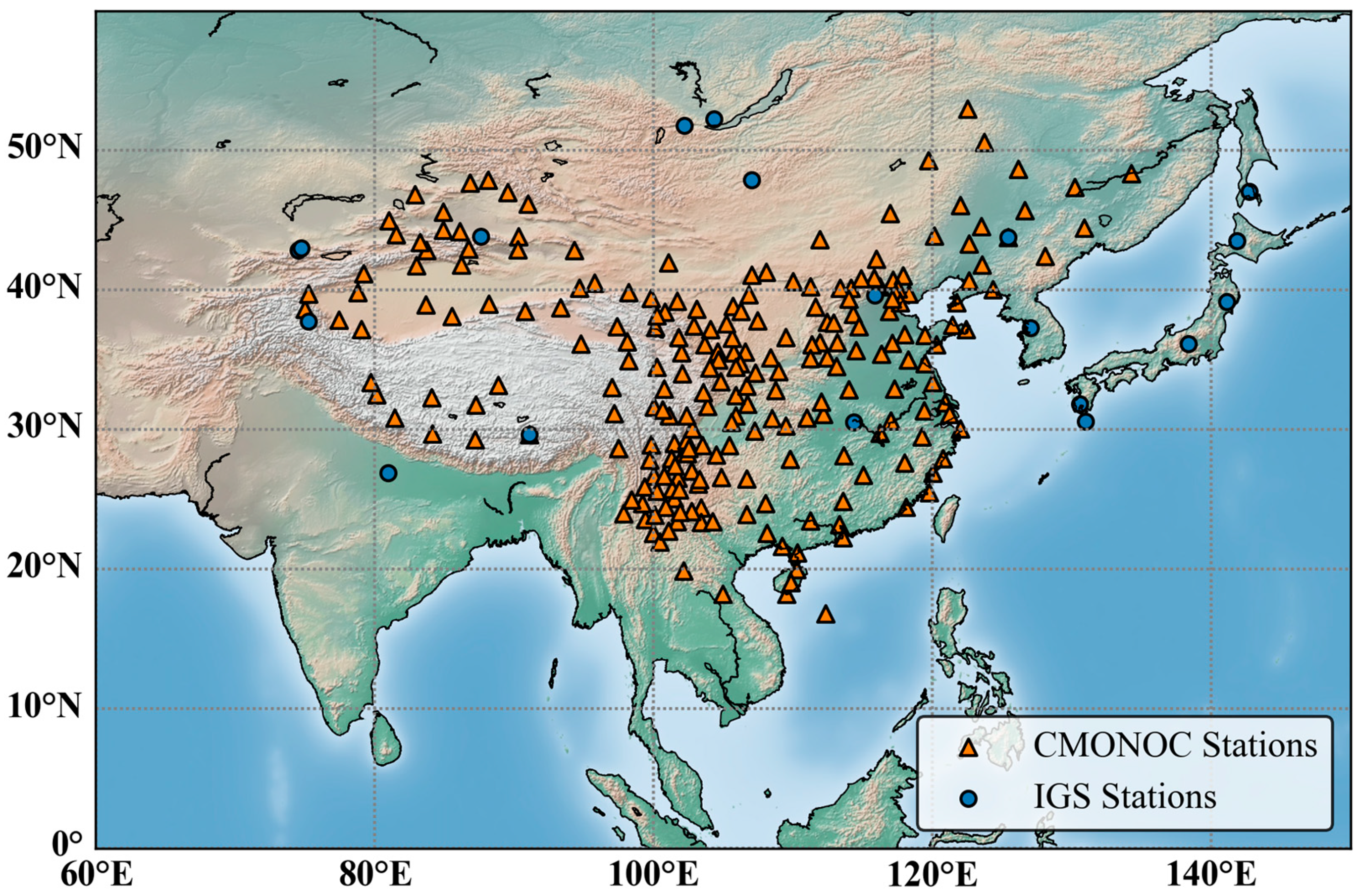
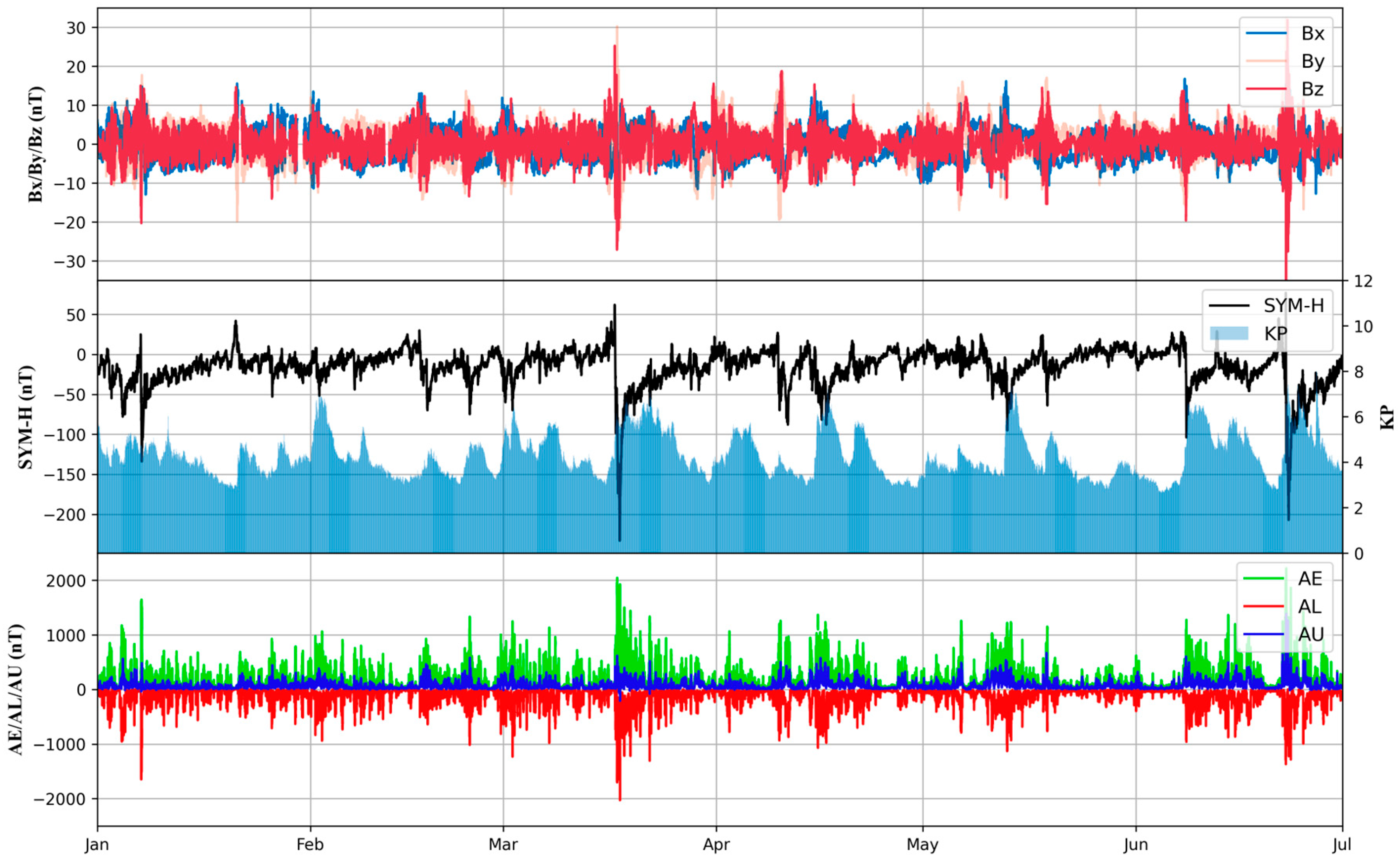
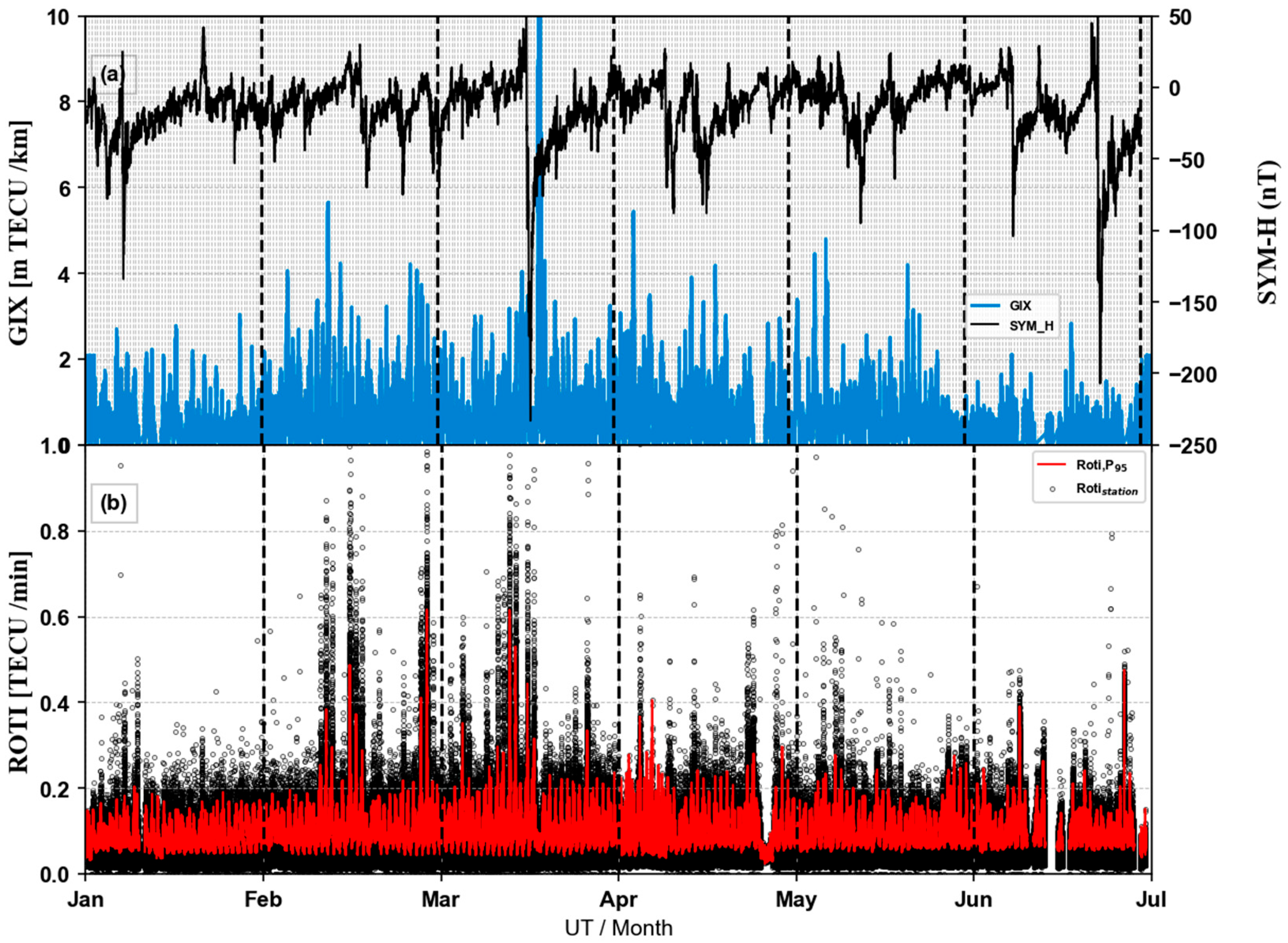

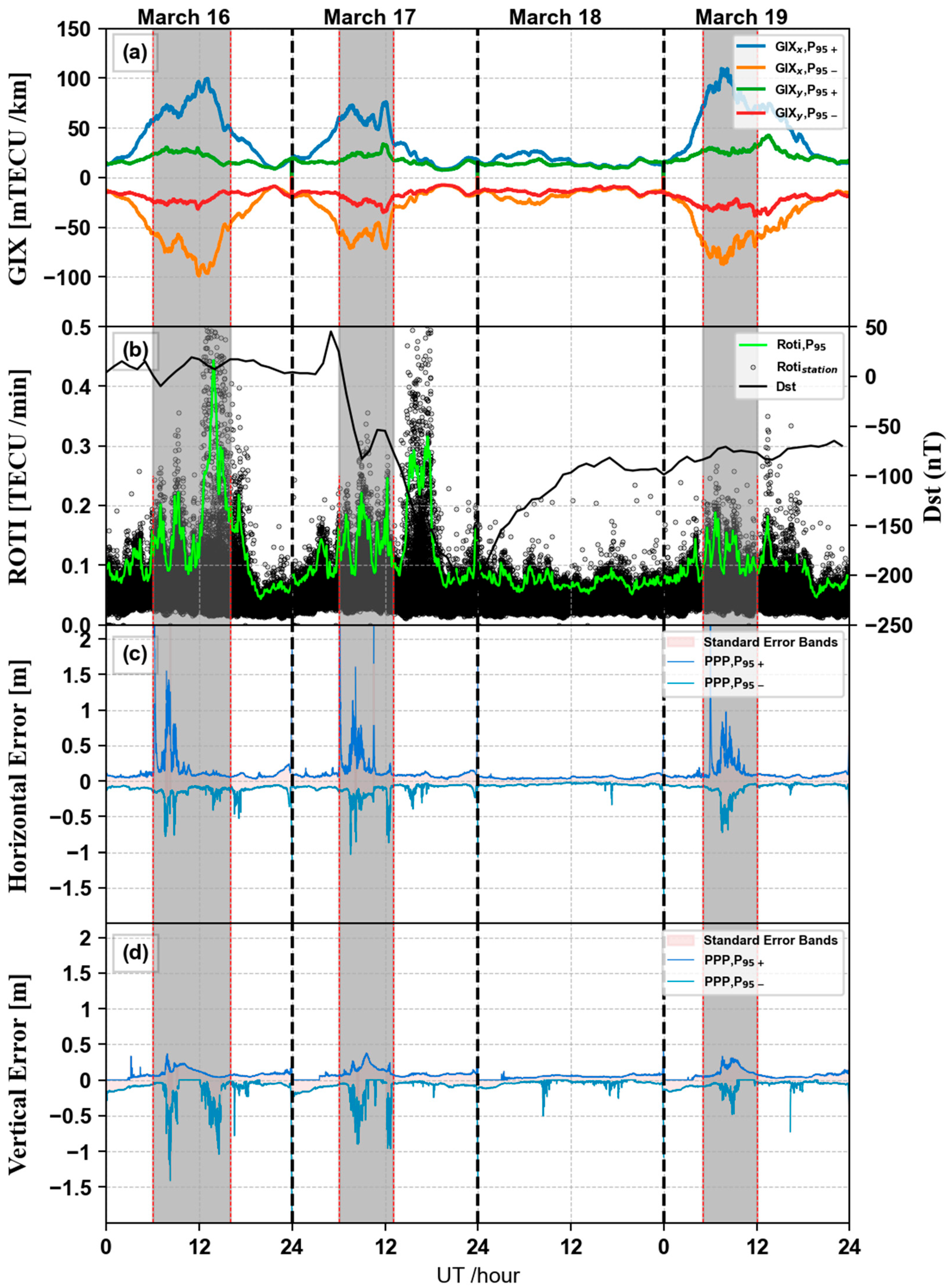
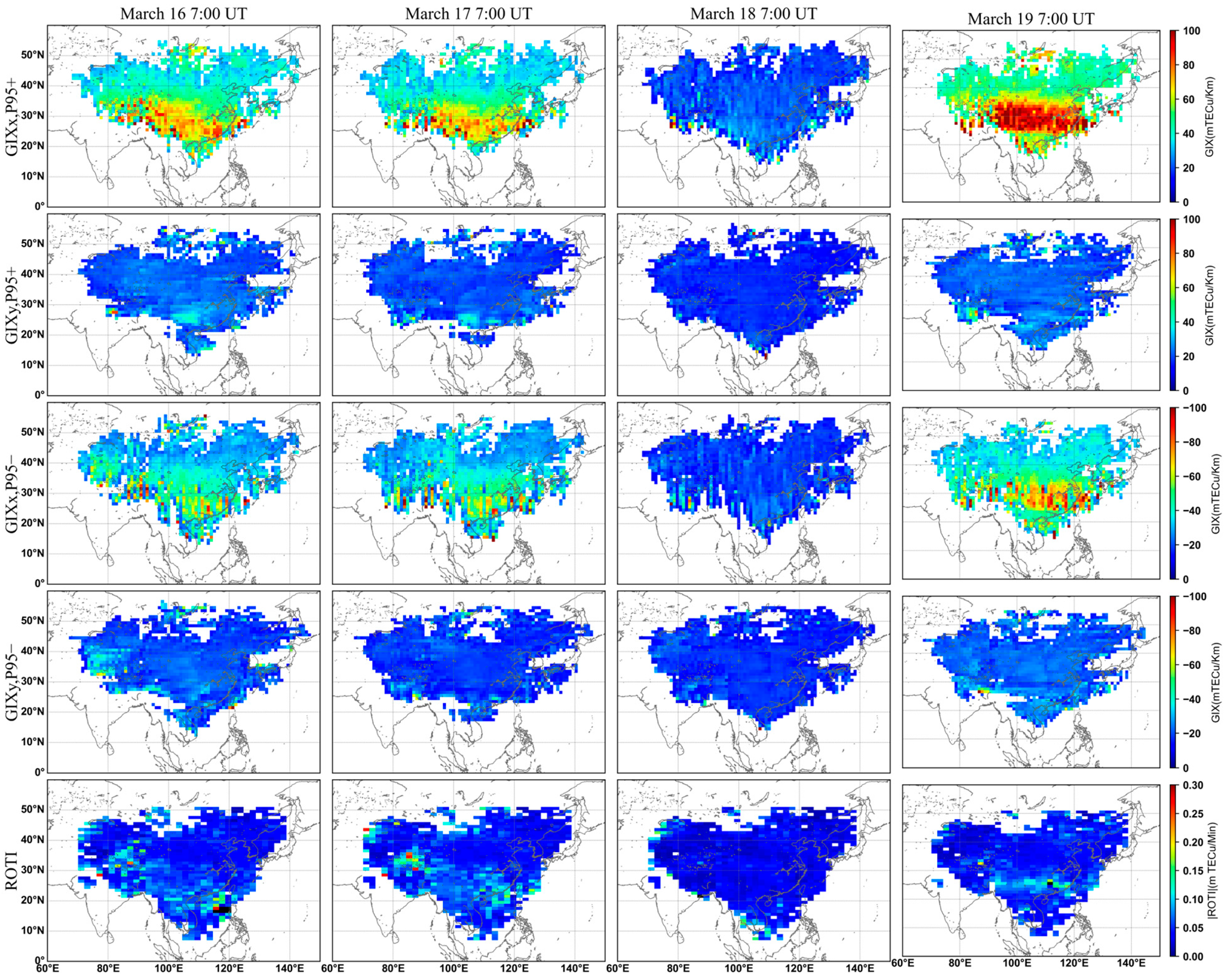

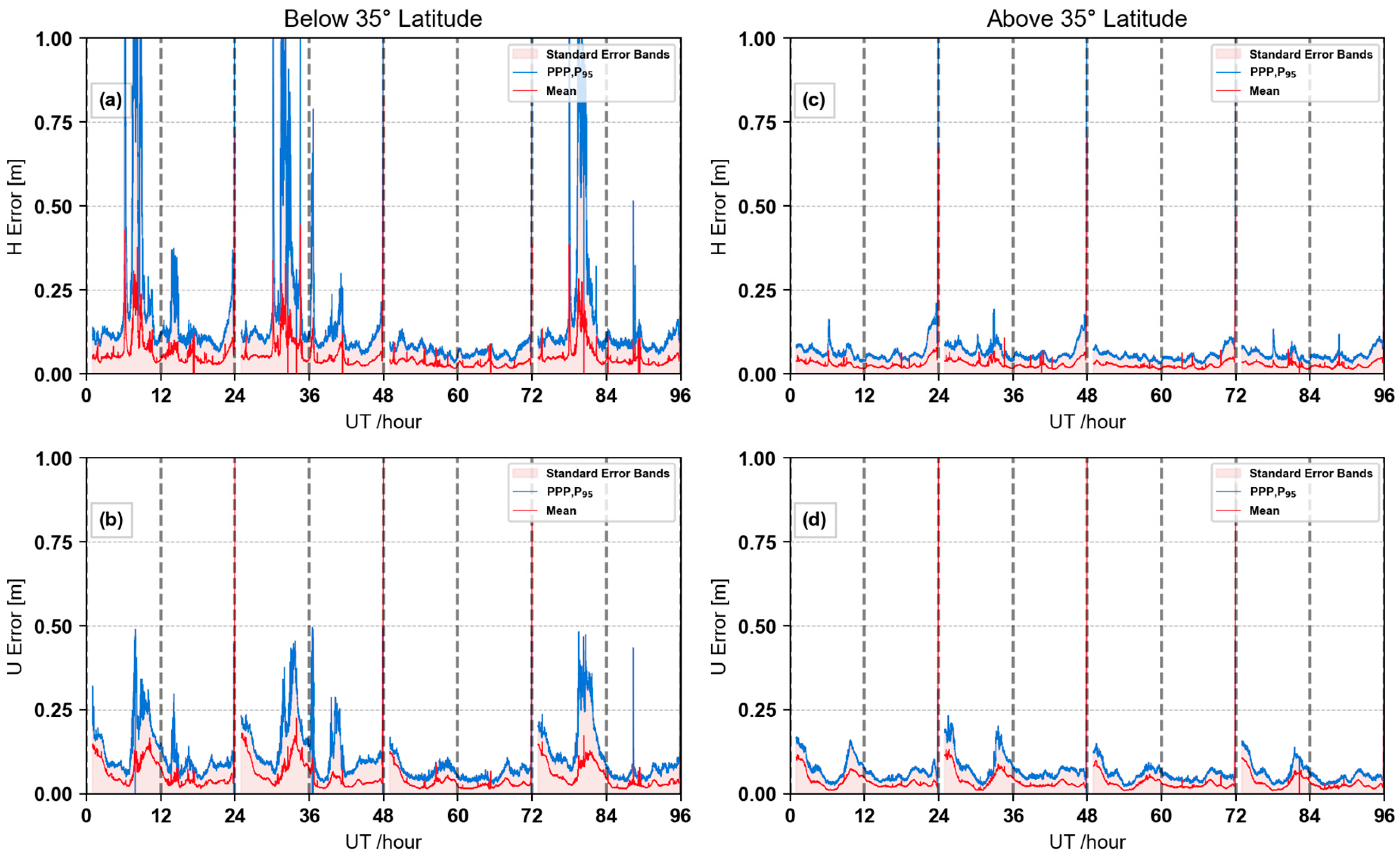
| Parameter | Configuration Details |
|---|---|
| Observation Data | GPS signals from both L1 and L2 frequencies |
| Weighting Strategy | Based on satellite elevation angles |
| Data Sampling Interval | 30 s |
| Elevation Mask | 10° minimum satellite elevation angle |
| Orbit and Clock Corrections | GFZ precise orbit and clock products |
| Processing Filter | Forward–backward Kalman filter (combined solution mode) |
| Ionospheric Delay Handling | Corrected using dual-frequency ionospheric-free combination |
| Tropospheric Delay Modeling | Hydrostatic delay modeled with Saastamoinen and NMF mapping function |
| Antenna Phase Center | Applied corrections using the igs14.atx model |
| Ambiguity Resolution | Continuous mode with floating ambiguities |
| DCB Correction | Corrected based on monthly DCB products |
| Tidal Effects | Corrections for solid Earth tides, ocean loading, and pole tides |
| Reference Solution | Average values of static PPP results obtained from previous day’s time period |
| Processing Mode | Kinematic PPP |
| Ionospheric Disturbance Index | GIX | ROTI |
|---|---|---|
| Temporal Resolution | 30 s | 5 min |
| Spatial Resolution | 1 × 1 degree | 1 × 1 degree |
| Detection Parameters | VTEC Horizontal Gradients | Spatial and Temporal Gradients of STEC |
| Ionospheric Propagation | Directional Features | Only Temporal and Spatial |
| Features | ||
| Scale of | mTECU/km | TECU/min |
| Ionospheric Disturbance |
Disclaimer/Publisher’s Note: The statements, opinions and data contained in all publications are solely those of the individual author(s) and contributor(s) and not of MDPI and/or the editor(s). MDPI and/or the editor(s) disclaim responsibility for any injury to people or property resulting from any ideas, methods, instructions or products referred to in the content. |
© 2025 by the authors. Licensee MDPI, Basel, Switzerland. This article is an open access article distributed under the terms and conditions of the Creative Commons Attribution (CC BY) license (https://creativecommons.org/licenses/by/4.0/).
Share and Cite
Fu, Z.; Wang, N.; Shen, X.; Li, A. Temporal and Spatial Analysis of the Impact of the 2015 St. Patrick’s Day Geomagnetic Storm on Ionospheric TEC Gradients and GNSS Positioning in China Using GIX and ROTI Indices. Remote Sens. 2025, 17, 2027. https://doi.org/10.3390/rs17122027
Fu Z, Wang N, Shen X, Li A. Temporal and Spatial Analysis of the Impact of the 2015 St. Patrick’s Day Geomagnetic Storm on Ionospheric TEC Gradients and GNSS Positioning in China Using GIX and ROTI Indices. Remote Sensing. 2025; 17(12):2027. https://doi.org/10.3390/rs17122027
Chicago/Turabian StyleFu, Zhihao, Ningbo Wang, Xuhui Shen, and Ang Li. 2025. "Temporal and Spatial Analysis of the Impact of the 2015 St. Patrick’s Day Geomagnetic Storm on Ionospheric TEC Gradients and GNSS Positioning in China Using GIX and ROTI Indices" Remote Sensing 17, no. 12: 2027. https://doi.org/10.3390/rs17122027
APA StyleFu, Z., Wang, N., Shen, X., & Li, A. (2025). Temporal and Spatial Analysis of the Impact of the 2015 St. Patrick’s Day Geomagnetic Storm on Ionospheric TEC Gradients and GNSS Positioning in China Using GIX and ROTI Indices. Remote Sensing, 17(12), 2027. https://doi.org/10.3390/rs17122027






